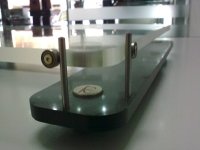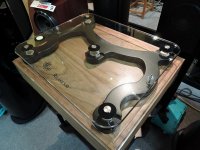I am not sure if this has been discussed yet. The search function did not give any hit.
Let's take two neodymium disc magnets with their same magnetic pole facing to each other, so there is a repelling force between them. The closer they are the bigger is the force. Put the magnets in a somewhat larger diameter PVC or copper tube, and support from both ends with some cylindrical rods.
This construction could act as a spring, used as feet of a turntable, amplifier, loudspeaker etc. If more weight should be supported, more magnets could be added.
Has anybody tried it?
Let's take two neodymium disc magnets with their same magnetic pole facing to each other, so there is a repelling force between them. The closer they are the bigger is the force. Put the magnets in a somewhat larger diameter PVC or copper tube, and support from both ends with some cylindrical rods.
This construction could act as a spring, used as feet of a turntable, amplifier, loudspeaker etc. If more weight should be supported, more magnets could be added.
Has anybody tried it?
I remember seeing this isolation platform, which is easy to diy. But is is not perfect, at higher frequencies there is coupling, not isolation. And how is magnetic repulsion better than springs or pneumatic isolation? It most likely isn't.
Attachments
Maybe you are right. A mass + spring system (and magnetic force is a spring, isn't it?) has a resonance frequency. This resonance has a Q that is most likely high. There should be some damping applied, which I don't see in any realization. Just watched the Maglevaudio turntable, and it wobbles for quite long time.
The one clear difference between magnetic repulsion and a mechanical spring is that the spring, in its linear range, reacts linearly to displacement, whereas the magnetic spring action is determined by the square of displacement. This could be a reason a magnetic spring needs less damping. It's also possible i have forgotten the little i knew about physics 🙂
- Home
- Design & Build
- Construction Tips
- Magnetic feet

